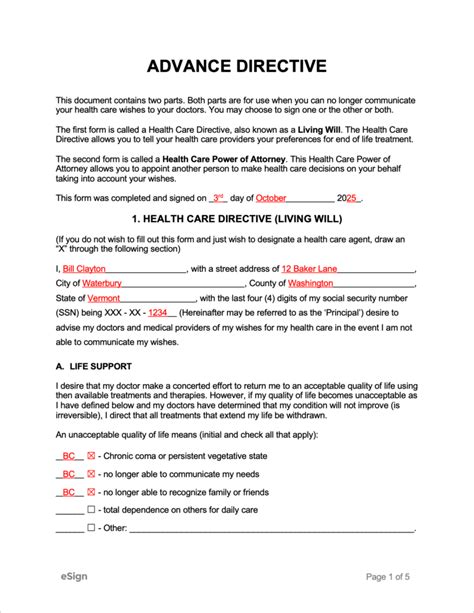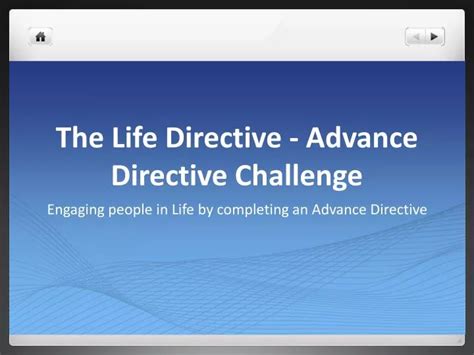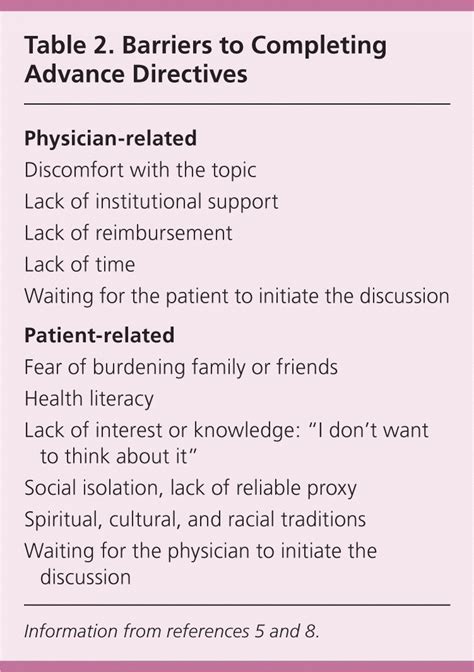Intro
Discover 5 essential tips for creating an advance directive, ensuring your healthcare wishes are respected. Learn about living wills, medical power of attorney, and end-of-life care planning to secure your future.
As we navigate the complexities of healthcare and planning for the future, it's essential to consider the importance of advance directives. These documents allow individuals to communicate their wishes regarding medical treatment and end-of-life care, ensuring that their values and preferences are respected. In this article, we'll delve into the world of advance directives, exploring their significance, benefits, and key considerations. Whether you're a healthcare professional, a patient, or simply someone looking to take control of your future, this information is crucial for making informed decisions.
Advance directives are not just for the elderly or those facing serious illnesses; they're a vital tool for anyone who wants to ensure that their autonomy and dignity are preserved, even in the face of uncertainty. By understanding the basics of advance directives and how they work, individuals can take a proactive approach to their healthcare, avoiding potential conflicts and misunderstandings. As we explore the topic further, we'll examine the different types of advance directives, their applications, and the steps involved in creating these essential documents.
The concept of advance directives may seem daunting, but it's a straightforward process that can bring peace of mind to individuals and their loved ones. By planning ahead, people can ensure that their wishes are respected, reducing the burden on family members and healthcare providers. In the following sections, we'll break down the key aspects of advance directives, providing practical guidance and expert insights to help readers make informed decisions about their future.
Understanding Advance Directives

Types of Advance Directives
There are several types of advance directives, each serving a specific purpose. Some of the most common include: * Living will: A document that outlines an individual's preferences for medical treatment, including end-of-life care. * Durable power of attorney for healthcare: A document that appoints a surrogate decision-maker to make medical decisions on behalf of the individual. * Do-not-resuscitate (DNR) order: A document that instructs healthcare providers not to perform CPR if an individual's heart stops or if they stop breathing. * Physician orders for life-sustaining treatment (POLST): A document that outlines an individual's preferences for medical treatment, including CPR, mechanical ventilation, and other life-sustaining interventions.Benefits of Advance Directives

Creating an Advance Directive
Creating an advance directive is a straightforward process that involves several steps: 1. Determine the type of advance directive needed: Individuals should consider their specific needs and preferences, choosing the type of advance directive that best aligns with their goals. 2. Choose a surrogate decision-maker: If an individual is creating a durable power of attorney for healthcare, they should choose a trusted friend or family member to serve as their surrogate decision-maker. 3. Outline preferences: Individuals should outline their preferences for medical treatment, including end-of-life care, in their advance directive. 4. Review and revise: Advance directives should be reviewed and revised regularly, ensuring that they remain relevant and effective.Challenges and Considerations

Addressing Challenges and Considerations
To address the challenges and considerations associated with advance directives, individuals and healthcare providers can take several steps: * Provide education and outreach: Educational programs and outreach initiatives can help raise awareness about the importance and benefits of advance directives. * Offer language access services: Healthcare providers can offer language access services, such as interpreters and translated documents, to ensure that individuals with limited English proficiency can access and understand advance directives. * Facilitate communication: Healthcare providers can facilitate communication between individuals, their loved ones, and surrogate decision-makers, ensuring that everyone is on the same page and that conflicts are minimized.Real-World Applications

Case Studies and Examples
Several case studies and examples illustrate the importance and benefits of advance directives: * A 75-year-old woman with dementia creates an advance directive, outlining her preferences for end-of-life care and appointing her daughter as her surrogate decision-maker. * A 40-year-old man with a terminal illness creates an advance directive, specifying that he wants to receive palliative care and outlining his preferences for medical treatment. * A healthcare provider uses an advance directive to facilitate communication between a patient, their loved ones, and their surrogate decision-maker, ensuring that everyone is on the same page and that the patient's wishes are respected.Best Practices and Recommendations

Future Directions and Research
Future research and initiatives should focus on improving access to and awareness of advance directives, particularly for underserved populations. Some potential areas of focus include: * Developing culturally and linguistically sensitive advance directives: Advance directives should be developed to meet the unique needs and preferences of diverse populations. * Improving language access services: Healthcare providers should offer language access services, such as interpreters and translated documents, to ensure that individuals with limited English proficiency can access and understand advance directives. * Facilitating communication and conflict resolution: Healthcare providers can facilitate communication between individuals, their loved ones, and surrogate decision-makers, ensuring that everyone is on the same page and that conflicts are minimized.As we conclude our exploration of advance directives, it's essential to remember that these documents are vital for ensuring that an individual's autonomy and dignity are preserved. By understanding the importance and benefits of advance directives, individuals can take a proactive approach to their healthcare, reducing stress and anxiety for loved ones and ensuring that their wishes are respected. We invite you to share your thoughts and experiences with advance directives, and to take action by creating your own advance directive or encouraging a loved one to do so.
What is an advance directive?
+An advance directive is a legal document that outlines an individual's preferences for medical treatment, including end-of-life care.
Why is it important to create an advance directive?
+Creating an advance directive ensures that an individual's autonomy and dignity are preserved, reducing stress and anxiety for loved ones and ensuring that their wishes are respected.
What types of advance directives are available?
+There are several types of advance directives, including living wills, durable powers of attorney for healthcare, do-not-resuscitate (DNR) orders, and physician orders for life-sustaining treatment (POLST).
